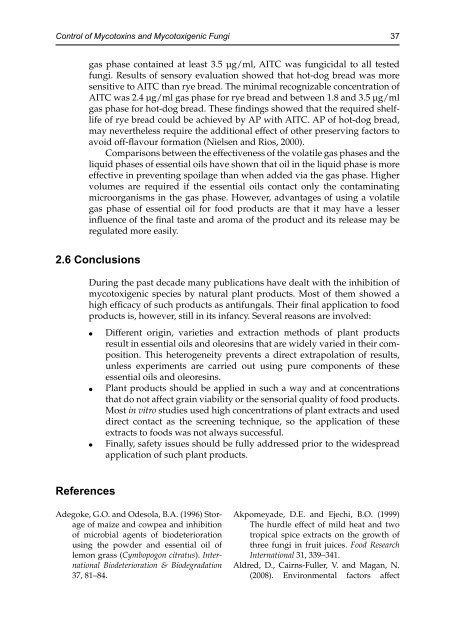Control of Mycotox<strong>in</strong>s and Mycotoxigenic Fungi 37gas phase conta<strong>in</strong>ed at least 3.5 μg/ml, AITC was fungicidal to all testedfungi. Results of sensory evaluation showed that hot-dog bread was moresensitive to AITC than rye bread. The m<strong>in</strong>imal recognizable concentration ofAITC was 2.4 μg/ml gas phase for rye bread and between 1.8 and 3.5 μg/mlgas phase for hot-dog bread. These f<strong>in</strong>d<strong>in</strong>gs showed that the required shelflifeof rye bread could be achieved by AP with AITC. AP of hot-dog bread,may nevertheless require the additional effect of other preserv<strong>in</strong>g factors toavoid off-flavour formation (Nielsen and Rios, 2000).Comparisons between the effectiveness of the volatile gas phases and theliquid phases of essential oils have shown that oil <strong>in</strong> the liquid phase is moreeffective <strong>in</strong> prevent<strong>in</strong>g spoilage than when added via the gas phase. Highervolumes are required if the essential oils contact only the contam<strong>in</strong>at<strong>in</strong>gmicroorganisms <strong>in</strong> the gas phase. However, advantages of us<strong>in</strong>g a volatilegas phase of essential oil for food <strong>products</strong> are that it may have a lesser<strong>in</strong>fluence of the f<strong>in</strong>al taste and aroma of the product and its release may beregulated more easily.2.6 ConclusionsDur<strong>in</strong>g the past decade many publications have dealt with the <strong>in</strong>hibition ofmycotoxigenic species by <strong>natural</strong> <strong>plant</strong> <strong>products</strong>. Most of them showed ahigh efficacy of such <strong>products</strong> as antifungals. Their f<strong>in</strong>al application to food<strong>products</strong> is, however, still <strong>in</strong> its <strong>in</strong>fancy. Several reasons are <strong>in</strong>volved:●●●Different orig<strong>in</strong>, varieties and extraction methods of <strong>plant</strong> <strong>products</strong>result <strong>in</strong> essential oils and oleores<strong>in</strong>s that are widely varied <strong>in</strong> their composition.This heterogeneity prevents a direct extrapolation of results,unless experiments are carried out us<strong>in</strong>g pure components of theseessential oils and oleores<strong>in</strong>s.Plant <strong>products</strong> should be applied <strong>in</strong> such a way and at concentrationsthat do not affect gra<strong>in</strong> viability or the sensorial quality of food <strong>products</strong>.Most <strong>in</strong> vitro studies used high concentrations of <strong>plant</strong> extracts and useddirect contact as the screen<strong>in</strong>g technique, so the application of theseextracts to foods was not always successful.F<strong>in</strong>ally, safety issues should be fully addressed prior to the widespreadapplication of such <strong>plant</strong> <strong>products</strong>.ReferencesAdegoke, G.O. and Odesola, B.A. (1996) Storageof maize and cowpea and <strong>in</strong>hibitionof microbial agents of biodeteriorationus<strong>in</strong>g the powder and essential oil oflemon grass (Cymbopogon citratus). InternationalBiodeterioration & Biodegradation37, 81–84.Akpomeyade, D.E. and Ejechi, B.O. (1999)The hurdle effect of mild heat and twotropical spice extracts on the growth ofthree fungi <strong>in</strong> fruit juices. Food ResearchInternational 31, 339–341.Aldred, D., Cairns-Fuller, V. and Magan, N.(2008). Environmental factors affect
38 S. Marín et al.efficacy of some essential oils and resveratrolto control growth and ochratox<strong>in</strong>A production by Penicillium verrucosumand Aspergillus westerdijkiae on wheatgra<strong>in</strong>. Journal of Stored Products Research44, 341–346.Amiri, A., Dugas, R., Pichot, A.L. andBompeix, G. (2008) In vitro and <strong>in</strong> vivoactivity of eugenol oil (Eugenia caryophylata)aga<strong>in</strong>st four important postharvestapple pathogens. InternationalJournal of Food Microbiology 126, 13–19.Atanda, O.O., Akpan, I. and Oluwafemi, F.(2007) The potential of some spice essentialoils <strong>in</strong> the control of A. parasiticus CFR223 and aflatox<strong>in</strong> production. FoodControl 18, 601–607.Awuah, R.T. and Ellis, W.O. (2002) Effects ofsome groundnut packag<strong>in</strong>g methods andprotection with Ocimum and Syzygiumpowders on kernel <strong>in</strong>fection by fungi.Mycopahologia 154, 29–36.Bluma, R., Amaiden, M.R. and Etcheberry, M.(2008) Screen<strong>in</strong>g of Argent<strong>in</strong>e <strong>plant</strong>sextracts: Impact on growth parametersand aflatox<strong>in</strong> B 1accumulation by Aspergillussection Flavi. International Journal ofFood Microbiology 122, 114–125.Bluma, R.V. and Etcheverry, M.G. (2008)Application of essential oils <strong>in</strong> maize gra<strong>in</strong>:impact on Aspergillus section Flavi growthparameters and aflatox<strong>in</strong> accumulation.Food Microbiology 25, 324–334.Caccioni, D. and Guizzardi, M. (1994) Inhibitionof germ<strong>in</strong>ation and growth of fruitand vegetable postharvest pathogenicfungi by essential oil components. Journalof Essential Oil Research 6, 173–179.Calori-Dom<strong>in</strong>gues, M.A. and Fonseca, H.(1995) Laboratory evaluation of chemicalcontrol of aflatox<strong>in</strong> production <strong>in</strong>unshelled peanuts (Arachis hypogaea L.).Food Additives and Contam<strong>in</strong>ants 12,347–350.Dh<strong>in</strong>gra, O.D., Jham, G.N., Rodrigues, F.A.,Silva Jr., G.J. and Costa, M.L.N. (2009)Fumigation with essential oil of mustardretards fungal growth and accumulationof ergosterol and free fatty acid <strong>in</strong> storedshelled groundnuts. Journal of StoredProducts Research 45, 24–31.Dikbas, N., Kotan, R., Dadasoglu, F. andSah<strong>in</strong>, F. (2008) Control of Aspergillusflavus with essential and methanol extractof Satureja hortensis. International Journalof Food Microbiology 124, 179–182.Doares, S.H., Syrovets T., Weller E.W. andRyan C.A. (1995) Oligalacturonides andchitosans activate <strong>plant</strong> defensive genesthrough the octadecanoid pathway. Proceed<strong>in</strong>gsof the National Academy of SciencesUSA 92, 4095–4098.Dubey, N.K., Tripathi, P. and S<strong>in</strong>gh, H.B.(2000) Prospects of some essential oils asantifungal agents. Journal of Medic<strong>in</strong>al andAromatic Plant Sciences 22, 350–354.Ejechi, B.O., Nwafor, O.E. and Okoko, F.J.(1999) Growth <strong>in</strong>hibition of tomato-rotfungi by phenolic acids and essentialoil extracts of pepperfruit (Dennetiatripetala). Food Research International 32,395–399.Fandohan, P., Gbenou, J.D., Gnonlonf<strong>in</strong>, B.,Hell, K., Marasas, W.F.O. and W<strong>in</strong>gfield,M.J. (2004) Effect of essential oils on thegrowth of Fusarium verticillioides andfumonis<strong>in</strong> contam<strong>in</strong>ation <strong>in</strong> corn. Journalof Agricultural and Food Chemistry 52,6824–6829.Guynot, M.E., Ramos, A.J., Seto, L., Purroy, P.,Sanchis, V. and Mar<strong>in</strong>, S. (2003) Antifungalactivity of volatile compoundsgenerated by essential oils aga<strong>in</strong>st fungicommonly caus<strong>in</strong>g deterioration ofbakery <strong>products</strong>. Journal of Applied Microbiology94, 893–899.Karthikeyan, M., Sandosskumar, R.,Radhajeyalakshmi, R., Mathiyazhagan, S.,Khabbaz, S.E., Ganesamurthy, K.,Selvi, B. and Velazhahan, R. (2007) Effectof formulated zimmu (Allium cepa L. xAllium sativum L.) extract <strong>in</strong> the <strong>management</strong>of gra<strong>in</strong> mold of sorghum. Journalof the Science of Food and Agriculture 87,2495–2501.Kim, J.H., Mahoney, N., Chan, K.L.,Molyneux, R.J. and Campbell, B.C. (2006)Controll<strong>in</strong>g food-contam<strong>in</strong>at<strong>in</strong>g fungi bytarget<strong>in</strong>g their antioxidative stressresponsesystem with <strong>natural</strong> phenoliccompounds. Applied Microbial and CellPhysiology 70, 735–739.


